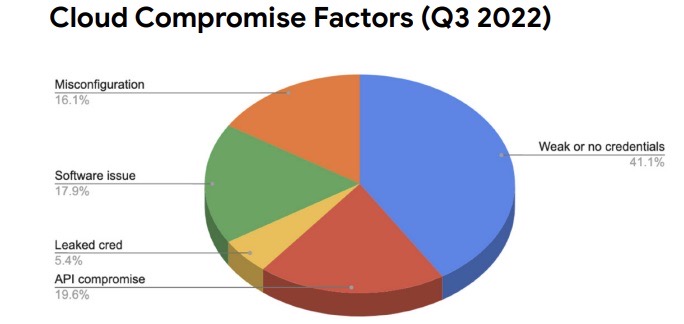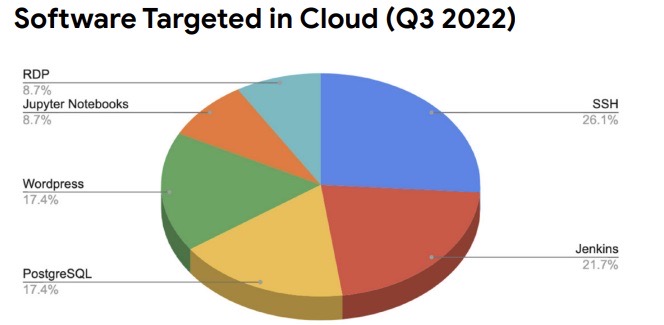Google: Monitor These Emerging Cloud Security Challenges in 2023

A new report from Google outlines a set of evolving threats that cloud security teams should keep an eye on in the new year.
In its latest “Threat Horizons” report, Google’s Cybersecurity Action Team details cloud security trends that it expects will have an impact in 2023 in areas including identity and access management (IAM), data backups and operational technology (OT.)
In this blog, we take a look at several of the trends discussed in the report, whose insights are aimed at helping cloud security teams increase their knowledge of emerging threats and improve their defense strategies.
Cloud providers’ IP addresses and open ports targeted with malware
After analyzing 2022 Q2 and Q3 data from its VirusTotal malware analysis service, Google found 6,000 malware samples actively communicating with Google Cloud Platform, Microsoft Azure and Amazon Web Services (AWS).
The malware samples, which were trying to contact either cloud services or customer-created workloads hosted by these three cloud service providers (CSPs), used either pre-specified or randomly selected IP addresses and TCP/IP ports.
“The malware also at times tried to hide its activities among legitimate services by communicating to CSPs using well-known ports, as well as by explicitly utilizing TLS,” the report reads.
Mitigation recommendations include:
- Monitor and restrict inbound and internal cloud network communications
- Use hardened virtual machine images
- Review cloud instance audit events for unexpected administrative or user activities
VPNs at risk from APT10 group
APT10, a cyber espionage threat actor sponsored by China, has fine-tuned its attacks, advancing from basic cloud account hijacking to more sophisticated compromising of virtual private network (VPN) technologies, according to Google.
By evolving its techniques in this manner, APT10, also known as MenuPass, is able to target the many organizations that rely on VPNs to protect connections in their hybrid on-prem/cloud environments.
“APT10’s ability to leverage both open source and custom tooling to target an organization’s unique infrastructure composition make them highly adept at identifying the inevitable weak spots of hybrid enterprises,” reads the report.
Google recommends that cybersecurity teams focus on and become experts not just on specific malicious technologies, but also on state-sponsored groups like APT10 that specialize in specific attacks – infrastructure access and control in APT10’s case.
OT systems to see increase in cloud attacks
The OT systems that control industrial operations are getting more and more integrated with cloud infrastructure. As a result, Google expects attackers to jump on this attack-surface expansion and attempt to breach OT systems via the cloud.
Recommended mitigations include:
- Make architecture design changes, such as:
- segmenting OT networks in a way that allows administrators to monitor and analyze their traffic in a way similar to internal IT networks
- Divide cloud services into different blocks and workload levels
- Ensure that OT data stored in the cloud is encapsulated and encrypted
- Assess the risks involved in integrating OT assets with the cloud
- Set up redundancy mechanisms and data backups
- Adapt procedures and train security staff to respond quickly to incidents involving cloud attacks against OT systems
Attackers zero-in on backups
To boost the impact of their ransomware attacks, threat actors are increasingly aiming to destroy victims’ data backups and interfere with tools used to create and manage backups.
To better protect these backup data stores and systems, Google recommendations include:
- Establish a cloud-specific backup strategy that, in addition to including data and machine-state backups, also contains configurations and templates of stored assets
- To prevent account compromises from providing attackers with a direct path to backup systems, configure IAM permissions to segment the access and roles for creating, deleting and changing backups
- Encrypt all backups and segregate key access roles
Cloud compromise trends
The report also looks at the top cloud compromise factors and at the most frequently targeted cloud software in 2022’s third quarter, both based on Google Cloud Platform customer data.
With regards to the cloud compromise factors, Google found that weak or non-existent passwords ranks at the top, the incidence of API key compromises has grown.

(Source: "Threat Horizons" report from Google's Cybersecurity Action Team, January 2023)
Meanwhile, Google has seen a growing diversity in the most commonly targeted cloud software.

(Source: "Threat Horizons" report from Google's Cybersecurity Action Team, January 2023)
For more information, read the report and a commentary about it from Google Senior Security Advisor Anton Chuvakin.
To learn more about cloud security challenges and trends:
- “Top challenges for cloud security in 2023” (SC Magazine)
- “The Cloud Is Under Attack: The State of Cloud Security in 2023” (CSO Online)
- “Securing 2023: Cloud security aspects that businesses need to know” (Digital Journal)
- “When It Comes to Effective Cloud Security, Sharing is Caring” (Tenable webinar)
VIDEOS:
Cloud Security for Dummies (SANS Institute)
Finding Cloud Security Balance and Perfecting Your Cloud Strategy (Cloud Security Alliance)
- Cloud


